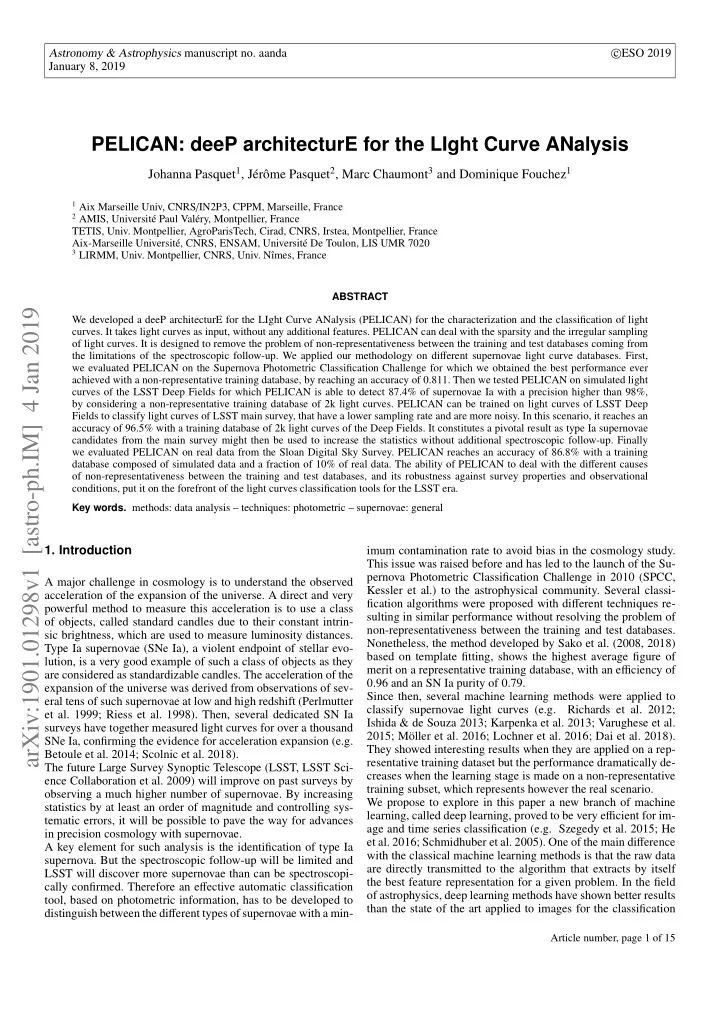

c Astronomy & Astrophysics manuscript no. aanda � ESO 2019 January 8, 2019 PELICAN: deeP architecturE for the LIght Curve ANalysis Johanna Pasquet 1 , Jérôme Pasquet 2 , Marc Chaumont 3 and Dominique Fouchez 1 1 Aix Marseille Univ, CNRS / IN2P3, CPPM, Marseille, France 2 AMIS, Université Paul Valéry, Montpellier, France TETIS, Univ. Montpellier, AgroParisTech, Cirad, CNRS, Irstea, Montpellier, France Aix-Marseille Université, CNRS, ENSAM, Université De Toulon, LIS UMR 7020 3 LIRMM, Univ. Montpellier, CNRS, Univ. Nîmes, France ABSTRACT arXiv:1901.01298v1 [astro-ph.IM] 4 Jan 2019 We developed a deeP architecturE for the LIght Curve ANalysis (PELICAN) for the characterization and the classification of light curves. It takes light curves as input, without any additional features. PELICAN can deal with the sparsity and the irregular sampling of light curves. It is designed to remove the problem of non-representativeness between the training and test databases coming from the limitations of the spectroscopic follow-up. We applied our methodology on di ff erent supernovae light curve databases. First, we evaluated PELICAN on the Supernova Photometric Classification Challenge for which we obtained the best performance ever achieved with a non-representative training database, by reaching an accuracy of 0.811. Then we tested PELICAN on simulated light curves of the LSST Deep Fields for which PELICAN is able to detect 87.4% of supernovae Ia with a precision higher than 98%, by considering a non-representative training database of 2k light curves. PELICAN can be trained on light curves of LSST Deep Fields to classify light curves of LSST main survey, that have a lower sampling rate and are more noisy. In this scenario, it reaches an accuracy of 96.5% with a training database of 2k light curves of the Deep Fields. It constitutes a pivotal result as type Ia supernovae candidates from the main survey might then be used to increase the statistics without additional spectroscopic follow-up. Finally we evaluated PELICAN on real data from the Sloan Digital Sky Survey. PELICAN reaches an accuracy of 86.8% with a training database composed of simulated data and a fraction of 10% of real data. The ability of PELICAN to deal with the di ff erent causes of non-representativeness between the training and test databases, and its robustness against survey properties and observational conditions, put it on the forefront of the light curves classification tools for the LSST era. Key words. methods: data analysis – techniques: photometric – supernovae: general 1. Introduction imum contamination rate to avoid bias in the cosmology study. This issue was raised before and has led to the launch of the Su- pernova Photometric Classification Challenge in 2010 (SPCC, A major challenge in cosmology is to understand the observed Kessler et al.) to the astrophysical community. Several classi- acceleration of the expansion of the universe. A direct and very fication algorithms were proposed with di ff erent techniques re- powerful method to measure this acceleration is to use a class sulting in similar performance without resolving the problem of of objects, called standard candles due to their constant intrin- non-representativeness between the training and test databases. sic brightness, which are used to measure luminosity distances. Nonetheless, the method developed by Sako et al. (2008, 2018) Type Ia supernovae (SNe Ia), a violent endpoint of stellar evo- based on template fitting, shows the highest average figure of lution, is a very good example of such a class of objects as they merit on a representative training database, with an e ffi ciency of are considered as standardizable candles. The acceleration of the 0.96 and an SN Ia purity of 0.79. expansion of the universe was derived from observations of sev- Since then, several machine learning methods were applied to eral tens of such supernovae at low and high redshift (Perlmutter classify supernovae light curves (e.g. Richards et al. 2012; et al. 1999; Riess et al. 1998). Then, several dedicated SN Ia Ishida & de Souza 2013; Karpenka et al. 2013; Varughese et al. surveys have together measured light curves for over a thousand 2015; Möller et al. 2016; Lochner et al. 2016; Dai et al. 2018). SNe Ia, confirming the evidence for acceleration expansion (e.g. They showed interesting results when they are applied on a rep- Betoule et al. 2014; Scolnic et al. 2018). resentative training dataset but the performance dramatically de- The future Large Survey Synoptic Telescope (LSST, LSST Sci- creases when the learning stage is made on a non-representative ence Collaboration et al. 2009) will improve on past surveys by training subset, which represents however the real scenario. observing a much higher number of supernovae. By increasing We propose to explore in this paper a new branch of machine statistics by at least an order of magnitude and controlling sys- learning, called deep learning, proved to be very e ffi cient for im- tematic errors, it will be possible to pave the way for advances age and time series classification (e.g. Szegedy et al. 2015; He in precision cosmology with supernovae. et al. 2016; Schmidhuber et al. 2005). One of the main di ff erence A key element for such analysis is the identification of type Ia with the classical machine learning methods is that the raw data supernova. But the spectroscopic follow-up will be limited and are directly transmitted to the algorithm that extracts by itself LSST will discover more supernovae than can be spectroscopi- the best feature representation for a given problem. In the field cally confirmed. Therefore an e ff ective automatic classification of astrophysics, deep learning methods have shown better results tool, based on photometric information, has to be developed to than the state of the art applied to images for the classification distinguish between the di ff erent types of supernovae with a min- Article number, page 1 of 15
Recommend
More recommend